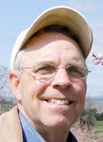
Arkansas has recently instituted a program that designates and honors farms that had been in the same family for 100 years, and the Morgan operation in both Lamar and Clarksville, Ark., was among the first, even though part of the farm was established almost 140 years ago. The operation that Steve and Carol Morgan run is highly diversified with cattle, turkeys and a pick-your-own peach orchard. Steve’s son, Mark, works full-time with his father on the farm which also supports three full-time employees. Steve said, “Every part of the operation has downtime, and the diversity allows us to keep everybody busy all of the time. In fact, we’ re never caught up.”
While everybody works on everything, Mark’s area of interest is with the commercial cattle herd. Mark said, “I prefer cattle and peaches to turkeys any day.” The Morgan herd is primarily an Angus/Gelbvieh cross and is comprised of 275 mommas and 15 bulls. The mommas are bred naturally and divided into several groups with most calving in the spring and one herd of 30 to 40 calving in the fall. The Morgans have 15 years of performance data on their herd, and primarily select bulls by using EPDs. Animals are pregnancy tested and culled by performance. The calves are weaned at 205 days and backgrounded for at least 45 days, with a goal of selling as yearlings, weather permitting.
The Butterball turkey operation consists of three smaller houses used for five weeks when the poults arrive. They are then moved to six larger houses where the hens mature to 14 pounds in a total of 12 weeks. These hens are raised for the Thanksgiving turkey market rather than larger birds mostly used for cold cuts or other processing. Currently their system works rotationally so that poults are in the smaller houses while larger birds are maturing in the six larger ones. However, because turkeys are housed for longer periods than chickens, disease is a constant issue. Steve said, “Rumor has it that the next thing down the turkey pike is stopping the rotational system and emptying an entire flock before bringing a new one in.”
Steve’s father started the turkey operation in the mid-1960s at which time bronze birds were preferred. Now almost all commercial turkeys are white because small white feathers missed in processing don’t upset the consumer. Another change has been in the genetics of both feed and birds tremendously increasing feed conversion rates. Years ago 21 weeks produced toms weighing 17 pounds with the same time frame now producing 30 pound birds. The current Morgan operation switched from toms to hens according to company specifications so the processing size at the plant stays constant and requires no equipment adjustments.
The Morgan operation freezes the dead birds which are recycled at a protein plant. While this process is a little more expensive, it is more convenient, an important consideration in a farm as diversified as theirs. Steve said, “The advantage with the turkey operation is the steady income because cattle and peaches are seasonal.”
Steve’s area of specialty is the peach orchard which contains 20 varieties- including heritage, newly developed and customer-requested varieties. Several years ago the old orchard fell victim to a root parasite promoted by too much moisture. The orchard had to be pulled up with the land needing to be dormant 10 to 20 years to cleanse the ground. That ground is now being converted to pasture since cattle are not impacted by the root parasite problem. A new orchard was planted three years ago and surprisingly produced a commercial crop after only two years rather than usual three. This is the third year, and a new peach shed will be built near the new orchard. Deer proved to be a serious problem at the new site requiring the replanting of about 2 acres and the installation of a deer fence.
Peach Pickin’ Paradise is one of the few survivors of what used to be a significant peach industry in the area. Customers are given a map of the orchard with the varieties labeled by row. Different varieties mature at different times with the season running usually from mid June to mid August. Last year, however, picking season started early due to especially good spring weather conditions. The orchard is watered by a sophisticated buried irrigation system connected to a pump whose water supply comes from one main pond with two others being emptied into the main pond as needed. Water is not an issue because the main pond is spring fed.
Mark looked around the farm and said, “When I was in high school I was more interested in sports, but I always knew this is where I wanted to be.”







